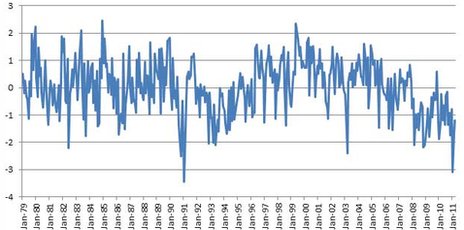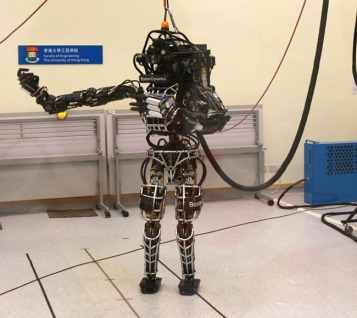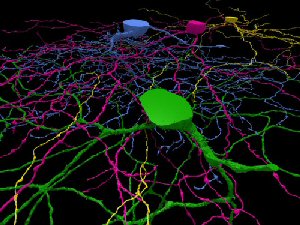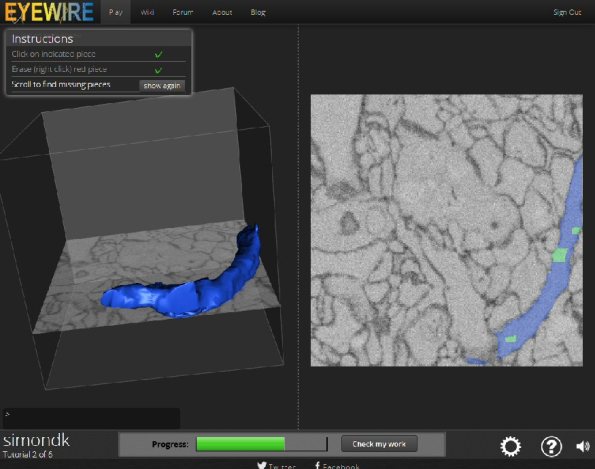Archive
Palm Pilot Inventor Wants to Open Source the Human Brain.
Wired article about brain inspired software:
Palm Pilot Inventor Wants to Open Source the Human Brain.
Hawkins founded the Redwood Center for Theoretical Neuroscience to study the brain full-time, and he co-authored On Intelligence with Sandra Blakeslee. In 2005, he co-founded Grok, originally known as Numenta, to turn his intelligence research into a marketable product.
But he wasn’t content to keep the company’s secrets to himself, so in addition to publishing a white paper outlining the theory and mathematics, the team has released NuPIC, an open source platform that includes the company’s algorithms and a software framework for building prediction systems with them.
Numenta Cortical Learning Algorithm.
Numenta Platform for Intelligent Computing (NuPIC).
And, maybe people should learn about it in new ways?
Radical New Teaching Method:
Wired: Learning in school could be so much more fun.
says Linda Darling-Hammond, a professor of education at Stanford and founding director of the National Commission on Teaching and America’s Future. “In 1970 the top three skills required by the Fortune 500 were the three Rs: reading, writing, and arithmetic. In 1999 the top three skills in demand were teamwork, problem-solving, and interpersonal skills. We need schools that are developing these skills.”
Theorists from Johann Heinrich Pestalozzi to Jean Piaget and Maria Montessori have argued that students should learn by playing and following their curiosity.
The study found that when the subjects controlled their own observations, they exhibited more coordination between the hippocampus and other parts of the brain involved in learning and posted a 23 percent improvement in their ability to remember objects. “The bottom line is, if you’re not the one who’s controlling your learning, you’re not going to learn as well,” says lead researcher Joel Voss, now a neuroscientist at Northwestern University.
Robots on the move.
Atlas Robot:
Atlas is a bipedal humanoid robot primarily developed by the American robotics company Boston Dynamics, with funding and oversight from the United States Defense Advanced Research Projects Agency (DARPA). The 6-foot (1.8 m) robot is designed for a variety of search and rescue tasks, and was unveiled to the public on July 11, 2013.
The atlas Robot on youtube:
Not to be left behind, popular science follows up with an article about similar “thought provoking” advances in robotics.
E.g. see: Creepy tech advances.
Computers with Schizophrenia:
– The neural network DISCERN –
Computer networks that can’t forget fast enough can show symptoms of a kind of virtual schizophrenia, giving researchers further clues to the inner workings of schizophrenic brains.
The results bolster a hypothesis known in schizophrenia circles as the hyperlearning hypothesis, which posits that people suffering from schizophrenia have brains that lose the ability to forget or ignore as much as they normally would. Without forgetting, they lose the ability to extract what’s meaningful out of the immensity of stimuli the brain encounters. They start making connections that aren’t real, or drowning in a sea of so many connections they lose the ability to stitch together any kind of coherent story.
“It’s an important mechanism to be able to ignore things,” says Grasemann. “What we found is that if you crank up the learning rate in DISCERN high enough, it produces language abnormalities that suggest schizophrenia.”
Robot-deceiver:
Professor Roland Arkin from the School of interactive computing at the University of Georgia presented the results of an experiment in which scientists were able to teach a group of robots to cheat and deceive. The strategy for such fraudulent behavior was based on the behavior of birds and squirrels.
After a while, the hiding robot started deliberately overturning obstacles just to create a diversion and was hiding somewhere away from the mess he had left behind. This strategy was not originally programmed, the robot has developed its own strategy, through trial and error.
So, surely, we need some rules: Governing Lethal Behavior – And there we go: Embedding Ethics in a Hybrid Deliberative/Reactive Robot Architecture –
Roland Arkin – Ethical Robots.
For the implementation of an ethical control and reasoning system potentially
suitable for constraining lethal actions in an autonomous robotic system.
Ruthless Robots:
By the 50th generation, the robots had learned to communicate—lighting up, in three out of four colonies, to alert the others when they’d found food or poison. The fourth colony sometimes evolved “cheater” robots instead, which would light up to tell the others that the poison was food, while they themselves rolled over to the food source and chowed down without emitting so much as a blink.
Imagination:
In an experiment, this supercomputer was given free access to the Internet and the ability to examine the contents of the network. There were no restrictions or guidelines.
There Google scientists created one of the largest neural networks for machine learning by connecting 16,000 computer processors, which they turned loose on the Internet to learn on its own.
Presented with 10 million digital images found in YouTube videos, what did Google’s brain do? What millions of humans do with YouTube: looked for cats.
Robot prophet:
“Nautilus” is another self-learning supercomputer. This unit was fed millions of newspaper articles starting from 1945, by basing its search on two criteria: the nature of the publication and location. Using this wealth of information about past events, the computer was asked to come up with suggestions on what would happen in the “future.”
News outlets which published online versions were also analysed, as was the New York Times’ archive, going back to 1945.
In total, Mr Leetaru gathered more than 100 million articles. Mood detection, or “automated sentiment mining” searched for words such as “terrible”, “horrific” or “nice”.
The Egypt graph, said Mr Leetaru, suggested that something unprecedented was happening this time.

Media “sentiment” around Egypt fell dramatically in early 2011, just before the resignation of President Mubarak.
“If you look at this tonal curve it would tell you the world is darkening so fast and so strongly against him that it doesn’t seem possible he could survive.”
Similar drops were seen ahead of the revolution in Libya and the Balkans conflicts of the 1990s.
Reports were analysed for two main types of information: mood – whether the article represented good news or bad news, and location – where events were happening and the location of other participants in the story.
Kurzweil is joining forces with Google
On December 14th 2012 there was a super-interesting post on Kurzweil.net that Kurzweil is joining forces with Google.
Ray Kurzweil confirmed today that he will be joining Google to work on new projects involving machine learning and language processing…
Ambitions certainly run high:
Im thrilled to be teaming up with Google to work on some of the hardest problems in computer science, so we can turn the next decades ”unrealistic” visions into reality.
As you read on, you begin to wonder, if this is really the start of Arthur C Clarkes 2025 Braincap vision.
See my Braincap article.
It is certainly all very intriguing:
On page 156 in Kurzweils ”How to Create a Mind” one reads that Kurzweil has started a new company called Patterns:
…Which intends to develop hierarchical self-organizing neocortical models that utilize HHMMs (Hierarchical Hidden Markov Models) and related techniques for the purpose of understanding natural language. An important emphasis will be on the ability for the system to design its own hierarchies in manner similar to a biological neocortex.
…
Our envisioned system will continually read a wide range of material, such as Wikipedia and other knowledge resources, as well as listen to everything you say and watch everything you write (if you let it).
The goal is for it to become a helpful friend answering your questions –
before you even formulate them
– and giving you useful information and tips as you go through the day.
So, finally Gordon Bells full MyLifeBits is under way …
Ten years later, Wireless Sensor Nets making automatic digital diaries and putting them directly out on the internet for you, and what have you from Futuropolis 2058, seems almost commonplace.
Obviously, IBMs Watson was only the start.
In Jeopardy a question is posed, and Watsons machinery goes to work. Its UIMA (Unstructured Information Management Architecture) deploys hundreds of subsystems, all of which are attempting to come up with a response to the Jeopardy query. I.e. more than 100 different techniques are used to analyze natural language, identify sources, find and generate hypotheses, find and score evidence, and merge and rank hypotheses. Finally, Watsons then acts as an expert system that combine the results of the subsystems. Helping to figure out how much confidence it has in the answers subsystems come up with.
Not only can Watson understand the Jeopardy queries, it can also search its 200 million pages of knowledge (Wikipedia and other sources) and come up with the correct answer faster than any human expert…
…
And that is just 2012 stuff. Kurzweill obviously won’t let us stop there.
On page 169 of ”How to Create a Mind” one reads that a better Watson should not only be able to answer a question, but also understand – pick out themes in documents and novels:
Coming up with such themes on its own from just reading the book, and not essentially copying the thoughts (even without the words) of other thinkers, is another matter.
Doing so would constitute a higher-level task than Watson is capable of today – it is what I call a Turing test-level task (That being said, I will point out that most humans do not come up with their own original thoughts either. But copy the ideas of their peers and opinion leaders).
At any rate this is 2012, not 2029, so I would not expect Turing test- level intelligence yet.
Intriguing indeed.
Arthur C. Clarke’s vision is surely well under way …
But even he didn’t anticipate a future where our memories belonged to the Cloud, Google or similar.
A cloud that will design its own cognitive hierarchies in a manner similar to a biological neocortex, based on our memories, and feed the result right back to us, shaping and directing our lives, as our most trusted friend.
-Simon
Simon Laub
www.simonlaub.net
Posted on UseNet, Dec. 17th 2012:
Newsgroups: rec.arts.sf.science, rec.arts.sf.written
From: Simon Laub
Date: Mon, 17 Dec 2012 23:43:03 +0100
Local: Mon, Dec 17 2012 11:43 pm
Subject: Kurzweil is joining forces with Google
EyeWire.
Interesting article in Wired Magazine, dec. 2012, about EyeWire:
By playing a game of colouring neurons, amateur neuroanatomists trace the wires of the retina, working together to find a neuronal ”wiring diagram”. Such a map, also known as the connectome, will help us understand how the retina serves visual perception.
Anyone can sign up to play; the only qualifications are curiosity and a zest for careful observation …
This is a new age of exploration. By recuiting enough amateur and professional scientist, we will be able to make significant breakthroughs in our understanding of the human brain.
Lead scientist on the project, Sebastian Seung, says that ”NeuroScientists have long hypothesized that our memories are encoded in our connectomes, because each experience leaves a trace on the brain by altering neural connections.
We will be able to test this hypothesis by attempting to read memories from connectomes”.
Exciting times ahead!
Try it here.
A Robotic Best Friend
I-SODOG, Your New, Robotic Best Friend:
Takara Tomy I-SODOG (Tokyo Toy Show 2012):
The Future of War: Military Robotics
With hardware made in China and with software written in India – military robots are coming. Not just one, but tens of thousands….
Drones: Unmanned naval attack jet moves closer to take-off
Unmanned naval attack jet moves closer to take-off:
Orgasm snapshot
One moment in time in different slices through the brain. More precisely, the brain of Kayt Sukel as she is having an orgasm, while being inside a brain scanner.
As the orgasm arrives, activity shoots up in two parts of the brain called the cerebellum and the frontal cortex, perhaps because of greater muscle tension. During orgasm, activity reaches a peak in the hypothalamus, which releases a chemical called oxytocin that causes pleasurable sensations and stimulates the uterus to contract. Activity also peaks in the nucleus accumbens, an area linked to reward and pleasure
Quotes from a Guardian newspaper article.
Speakers Club arrangement med Per Wimmer
Var idag til Speakers Club arrangement med Per Wimmer.
På deres hjemmeside skriver Speakers Club:
….finansmanden Per Wimmer – den moderne eventyrer, der i 2013, som den første dansker vil bryde den ultimative grænse – at rejse i rummet. Forinden da, vil han i juli 2012 dykke ned til Titanic, der ligger i 3.8 km dybde.
Per Wimmer er 41 år, millionær og indehaver af investeringsbanken Wimmer Financial i London.
Han har to studenterhuer, eksamener fra både Københavns Universitet, Europakollegiet i Brügge, University of London og Harvard, og imellem studierne har han arbejdet som assistent for EU-kommissær Henning Christoffersen i Europakommissionen og som konsulent for McKinsey. Efter Harvard arbejdede Wimmer i en stilling som investeringsrådgiver og siden afdelingsdirektør i investeringsbanken Goldman Sachs. Da banken gik på børsen, kunne den unge Wimmer lægge nogle millioner til sin pæne årsløn. Kort derefter købte han sin første billet til rummet.
Siden har han været aktierådgiver i Collins Stewart og i MF Global/Man Securities.
Speakers Club havde lagt denne inspirations video ud før arrangementet:
Før Per Wimmer gik på scenen blev alle vi tilhørere bedt om at fortælle vores allerstørste drøm til vores sidemand (i.e. kan man ikke det, er det næppe sandsynligt at drømmen er ret godt formuleret, og derved heller ikke sandsynligt at noget kan ske).
Således testede kom Per ind – iført rumdragt –
Som Speakers Club manden sagde – en mand med en drøm, som har handlet på det.
Først var der en kort introduction til hans liv som finansmand i London, Wimmer Financial – og det job hos Goldman Sachs, som gør ham rig nok til at holde ferie 365 dage om året, og forfølge drømmene.
Derefter gik vi over til det egentlige – visionen om rummet.
Se detaljerne på Wimmer Space.
Vi mennesker lever hele vores liv i et 11 km bånd. Vi kommer maksimalt 10 km op. Og max 1 km ned. Det vil han gerne udvide – længere ned, og navnligt højere op.
Per har sat sin mission statemement op (sådan een har alle fornuftige mennesker jo):
1. Think out the box.
2. Follow (feel) heart and passion.
3. Focus and execution.
(udfør, udfør, udfør – vær fokuseret, og få tingene gjort. En af gangen).
4. Time discipline. Alle resourcer kan vindes og tabes igen – bortset fra tid. Så man skal være meget omhyggelig med hvad man bruger tiden til.
5. Teamwork. Sum of all the parts is greater than the individual parts.
6. Calculate risk. Risk reward ratio. Upside vs. downside.
Giver det nok at forfølge det givne mål.
7. Inspire others. esp. Children.
Encourage others. Opmuntre andre til at udleve deres drøme.
—
Hans første projekt var Mt. Everest. Ifølge Per er chancen for at dø her 10 % ved hver opstigning (internet er lidt uenig, og giver 2 % – risk of dying on Everest – 216 døde, og 3,142 havde nået toppen i 2010.
In the last ten years, advances in climbing equipment and more experienced guides have resulted in a steep drop in fatality statistics: from 37% in 1990 to 4.4% in 2004.
Men for en rigtig eventyrer er det jo heller ikke sjovt at være nr. 3.143 ….Så med relativ høj risici og ikke megen fame and fortune, lavede han så istedet et Mount Everest Skydrive:
Per var med i første gruppe der lavede i Everest Skydives 2008. Nu er det vist nærmest rutine, og noget der kan købes som pakkerejser….
Lufthavnen (skydivet startede fra, og landede ved) oppe på Everest ser dog stadig noget usikker ud …
Han var så sådan set klar til turen med Virgin Galactica op i rummet. Men desværre har der været en del forsinkelser. Så han er først med der i 2013. Og han skulle jo også lave noget i 2012 – så der dykker han ned til Titanic her i sommerferien.
Lidt uklart for mig hvem der egentlig arrangerede (om det var Per eller nogen andre), men hos en arrangør, Centennial Titanic dive, kommer man med for 300.000 (from $ 66,257 pp (for submarine divers) to $12,498 pp (for Non Submarine Divers) – hvilket jo er et fund for prisen.
Mange spændende detaljer om Titanic (vi fik også en bog om vraget) –
Stort skib, 269 m langt. Megen historie. Se Titanic.
Sej tur med at sejle rundt i undervandsbåd (der er kun 5 ubåde i verden der kan gå så langt ned, 3.8 km) om forstavnen. 3 timer dyk ned, og 3 timer op igen.
Efter det holdes eventyr-lysten levende med et forsøg på at lave hastigheds rekord på landjorden i diverse amerikanske ørkener.
Målet er der 800 miler/pr hour. i en raketmotor man har sat hjul på.
Div flymekanikere fra Boing fabrikkerne arbejder med på det projekt. Og Per og Ed skiftes så til at side i maskinen ….
Men ellers er der jo astronaut træningen:
Der er Fighter Jet Flying:
The MIG 25 reaches speeds around Mack 2.5 – 3.0 (approx. 2.500 – 3.000 Km/h) and reaches altitudes at the edge of space
Se MIG 25.
Som Per har prøvet flere gange i Rusland. Lyder som et værre hostende, rystende, skrammel fly … 🙂 Der bare flyver vanvittigt hurtigt.
Incredibel adventures sælger turene for ca. $17.000 dollars, se Adventures.
Hvor man så for ladet sit fly op med 14 tones brændstof. Den russsiske pilot brænder det så af for een, når han da ikke på dårligt engelsk overlader styrepinden til een (man står der for forsvaret af moder Rusland?).
Og ifølge Per, også Topgun lignende akrobatik omkring det russiske kontrol tårn …. drikker man også vodka i cockpittet tænker man så?
Så er der zero g træning:
Zero-G flights aim at building up resistance and level of comfort in the state of weighlessness. Specially designed Russian built Ilyushin 76 planes nose dives from approx. 14 km of altitude, creating approx. 30 seconds of weightlessness
Og centrifuge træning:
The ABB centrifuge is one of the largest centrifuges in world and capable of delivering up to 30 G for non-human experiments; the human body can only resist up to 12 G. An F 16 fighter pilot must withstand 7.5 G to qualify
Altsammen i Rusland.
Der er herlige videoer på Wimmer space siden fra træningen.
Men det skal jo ende med rigtige missioner, og Per har så foreløbigt købt sig 3 ture.
Først i slutningen af 2013 med Virgin Galactica, Virgin Space.
Tickets cost $200,000 and deposits start from $20,000.
Meget kort tid efter med http://www.incredible-adventures.com/xcor-lynx.html. Hvilket er en rigtigt ”right stuff”experience.
Og så hos Space adventures, som jeg forstod det. Som allerede har sendt folk kommercielt op.
Charles Simony m.fl.
Detaljerne omkring mission 3 virkede dog noget usikre. Men jeg forstod det sådan at nr. 3 også var booket.
De 2 første virkede mere sikre. Og skulle være ready to go.
Og endelig er der jo selvfølgelig den langsigtede ambition om at komme til Månen.
I pausen lovede Per mig at der vil være live streaming ud på Wimmer Space sitet fra hans første tur med Virgin Galactica i 2013.
Det glæder jeg mig rigtigt meget til at se!





